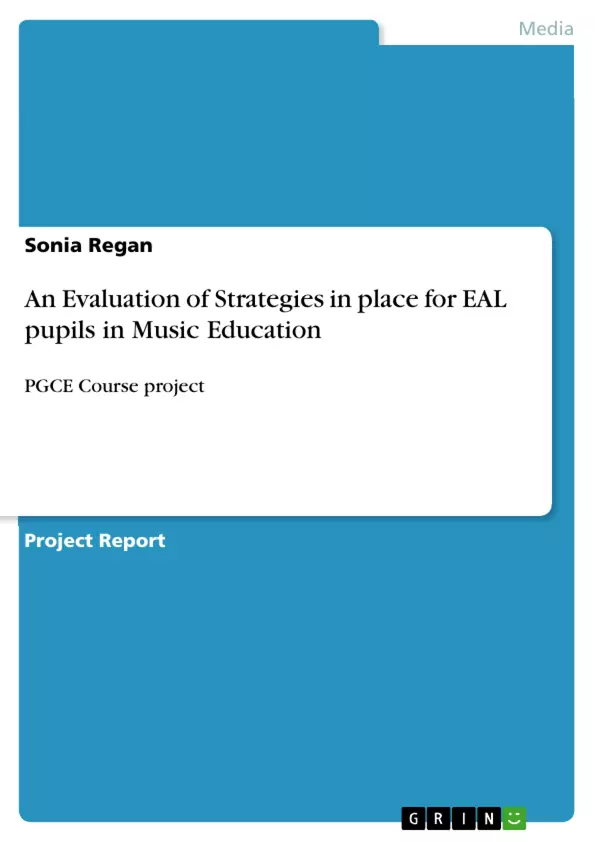I chose the subject of this survey for a number of reasons. Firstly, I could be classed as an EAL student, because, coming from Malaysia, English is not my first language. Secondly, St Paul’s College, the school where I am taking my 2nd placement as a trainee music teacher has a high proportion of EAL pupils- 281 out of a total of 1069. There are 35 languages spoken by pupils at this school and it has problems in caring for the requirements of so many EAL speakers- mainly connected with the lack of trained staff able to deal effectively with EAL. There are two part time EAL teachers, one of whom shares this subject with teaching English, and one other voluntary assistant. The shortcomings of the way EAL is managed in the school are discussed and attempts made to improve on it at various staff meetings. One point which is of particular concern is that many EAL pupils have a lower level of achievement than English speaking pupils of the same age. The school does have a detailed policy on EAL teaching, including interviews with EAL pupils, assessment of their situations and a list of strategies for teaching and assimilating them into the school community.
Inhaltsverzeichnis (Table of Contents)
- National policy on EAL- an overview
- School concerns and policy for EAL
- Learning theories and EAL
- Evaluation of strategies for teaching EAL pupils
- Evaluation of Methodology
- Observation of classes
Zielsetzung und Themenschwerpunkte (Objectives and Key Themes)
This report examines the strategies in place for English as an Additional Language (EAL) pupils in Key Stage 3 music education at St Paul's College. It aims to analyze the effectiveness of current approaches and identify areas for improvement. The report draws upon national policy guidelines, learning theories, and observations of classroom practices.
- National policy on EAL and its implementation in schools
- Challenges and concerns regarding EAL support in schools
- Learning theories related to language acquisition and development for EAL learners
- Strategies for teaching EAL pupils, including Visual, Auditory, and Kinaesthetic (VAK) learning styles
- Evaluation of existing strategies and the need for additional resources and support
Zusammenfassung der Kapitel (Chapter Summaries)
- National policy on EAL- an overview: This chapter provides an overview of the national policy on EAL, highlighting the importance of creating a welcoming environment, providing adequate support, and fostering collaboration between EAL and class teachers.
- School concerns and policy for EAL: This chapter focuses on the specific challenges faced by St Paul's College in supporting its large EAL population. It discusses the school's existing policy on EAL and the need for additional resources, including full-time EAL specialist teachers.
- Learning theories and EAL: This chapter explores relevant learning theories, including Bruner's work on language and thinking, Vygotsky's theory of socio-cultural development, and Cummins' distinction between BICS and CALP. It emphasizes the importance of understanding these theories in relation to teaching EAL learners.
- Evaluation of strategies for teaching EAL pupils: This chapter outlines the author's approach to teaching EAL pupils based on VAK learning styles. It also discusses the methods used to evaluate strategies in place at St Paul's, including observation of classes and interviews with pupils and staff.
- Evaluation of Methodology: This chapter further elaborates on the methods used in the evaluation, providing a detailed description of the observations, interviews, and discussions conducted. It also discusses specific examples of EAL support provided by the school.
- Observation of classes: This chapter presents observations of EAL pupils in year 7 music classes, focusing on their level of English proficiency, their learning experiences, and the challenges they face.
Schlüsselwörter (Keywords)
The primary keywords and focus topics of this report include English as an Additional Language (EAL), EAL support, national policy, learning theories, VAK learning styles, classroom observation, evaluation, teaching strategies, and the challenges faced by EAL pupils in a secondary school setting.
- Citation du texte
- Sonia Regan (Auteur), 2010, An Evaluation of Strategies in place for EAL pupils in Music Education, Munich, GRIN Verlag, https://www.grin.com/document/166951



